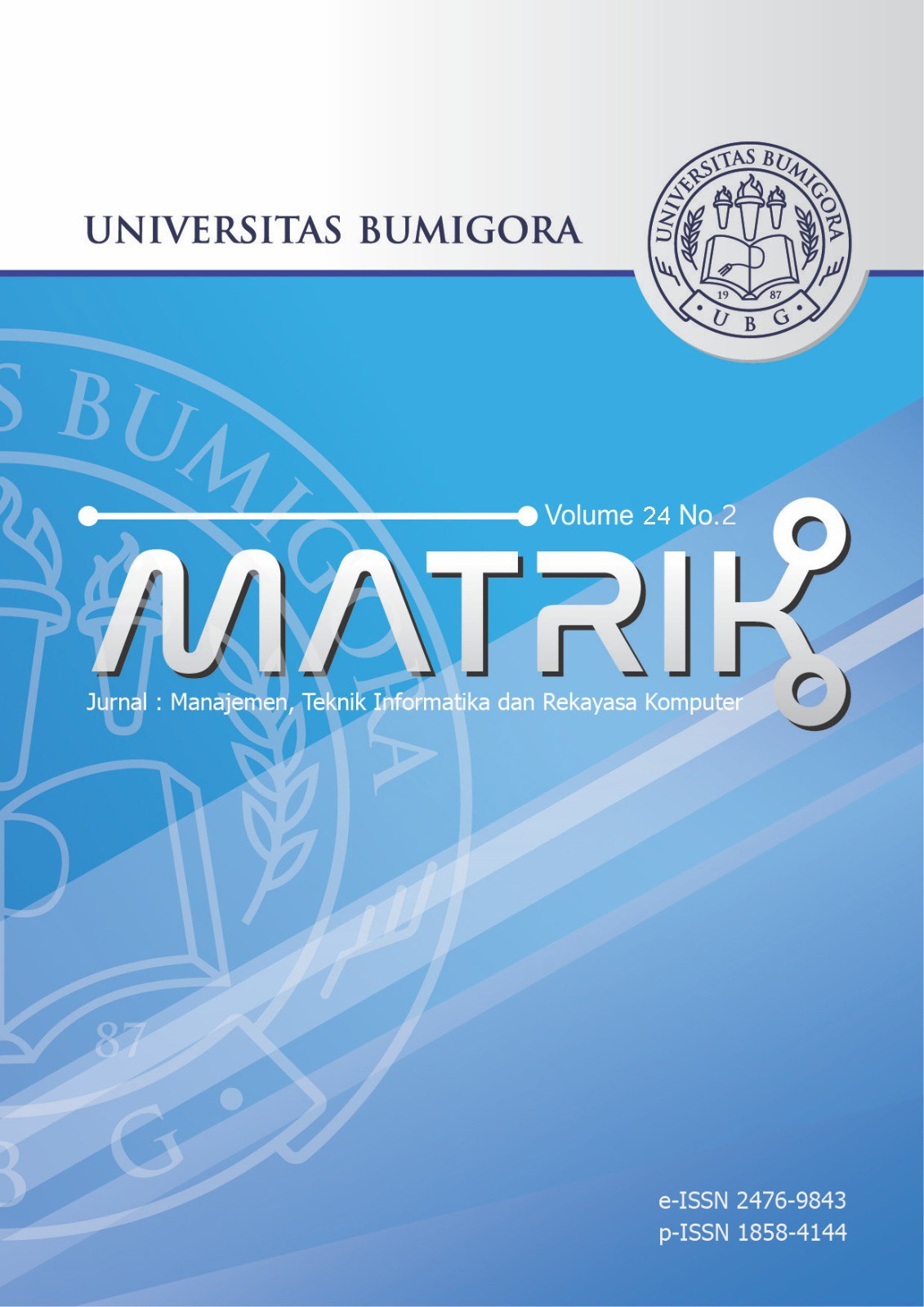A Image Classification of Poisonous Plants Using the MobileNetV2 Convolutional Neural Network Model Method
DOI:
https://doi.org/10.30812/matrik.v24i2.4284Keywords:
Accuracy, Convolutional Neural Network, Image Classification, MobileNetV2, Poisonous PlantsAbstract
Poisonous plants can be dangerous for many people, but some can be used as medicines or as pest killers. Some people, especially those in environments with a wide variety of plants, can take advantage of this poisonous plant. Lack of knowledge and information causes the use of this poisonous plant to be inappropriate. This research aims to develop software to classify images of poisonous plants using the Convolutional Neural Network method with the MobileNetV2 model and to compare the accuracy of classification results with various dataset configurations and varying parameters. The research method used is a Convolutional Neural Network, which has relatively high accuracy in classifying various digital images. The data used in this research consists of eight poisonous plants and several non-poisonous plants. The research results on 153 test data show that the accuracy value was 99.34%, precision was 99%, recall was 99%, and F1-Score was 99%. This research contributes to developing software that can quickly provide information and knowledge about poisonous plants, offering a high-accuracy solution for classifying poisonous plants using image data. Furthermore, implementing MobileNetV2 provides an efficient and lightweight model suitable for deployment on mobile devices, enhancing accessibility and usability in the field. The potential applications of this software extend beyond individual use, potentially benefiting agricultural, medical, and educational sectors. Future work will expand the dataset to include more plant species and refine the model to improve its robustness against diverse environmental conditions and image qualities.
Downloads
References
vol. 8, no. 2, pp. 68 828–68 841, 2020, https://doi.org/10.1109/ACCESS.2020.2986946.
[2] D. Sinaga, C. Jatmoko, and N. Hendriyanto, “Multi-Layer Convolutional Neural Networks for Batik Image Classification,â€
Scientific Journal of Informatics, vol. 11, no. 2, pp. 477–484, 2024, https://doi.org/10.15294/sji.v11i2.3309.
[3] S. Manoharan J, “Flawless Detection of Herbal Plant Leaf by Machine Learning Classifier Through Two Stage Authentication
Procedure,†Journal of Artificial Intelligence and Capsule Networks, vol. 3, no. 2, pp. 125–139, 2021, https://doi.org/10.36548/
jaicn.2021.2.005.
[4] O. D. Nurhayati, “Pengolahan Citra untuk Identifikasi Jenis Telur Ayam Lehorn dan Omega-3 Menggunakan K-Mean Clustering
dan Principal Component Analysis,†Jurnal Sistem Informasi Bisnis, vol. 10, no. 1, pp. 84–93, 2020, https://doi.org/10.21456/
vol10iss1pp84-93.
[5] M. H. IBRAHIM, “WBA-DNN: A hybrid weight bat algorithm with deep neural network for classification of poisonous and
harmful wild plants,†Computers and Electronics in Agriculture, vol. 190, no. 2, pp. 1–10, 2021, https://doi.org/10.1016/j.
compag.2021.106478.
[6] R. Azadnia, F. Noei-Khodabadi, A. Moloudzadeh, A. Jahanbakhshi, and M. Omid, “Medicinal and poisonous plants classification
from visual characteristics of leaves using computer vision and deep neural networks,†Ecological Informatics, vol. 82,
no. 1, pp. 1–12, 2024, https://doi.org/10.1016/j.ecoinf.2024.102683.
[7] X. Yan, X. Peng, Y. Qin, Z. Xu, B. Xu, C. Li, N. Zhao, J. Li, Q. Ma, and Q. Zhang, “Classification of plastics using laserinduced
breakdown spectroscopy combined with principal component analysis and K nearest neighbor algorithm,†Results in
Optics, vol. 4, no. 2, pp. 1–9, 2021, https://doi.org/10.1016/j.rio.2021.100093.
[8] G. Batchuluun, S. H. Nam, and K. R. Park, “Deep learning-based plant classification and crop disease classification by thermal
camera,†Journal of King Saud University - Computer and Information Sciences, vol. 34, no. 10, pp. 10 474–10 486, 2022,
https://doi.org/10.1016/j.jksuci.2022.11.003.
[9] T. S. Xian and R. Ngadiran, “Plant Diseases Classification using Machine Learning,†Journal of Physics: Conference Series,
vol. 2, no. 1, pp. 1–13, 2021, https://doi.org/10.1088/1742-6596/1962/1/012024.
[10] K. B. Obaid, S. R. M. Zeebaree, and O. M. Ahmed, “Deep Learning Models Based on Image Classification: A Review,â€
International Journal of Science and Business, vol. 4, no. 11, pp. 75–81, 2020, https://doi.org/10.5281/zenodo.4108433.
[11] X. Cao, J. Yao, Z. Xu, and D. Meng, “Hyperspectral Image Classification with Convolutional Neural Network and Active
Learning,†IEEE Transactions on Geoscience and Remote Sensing, vol. 58, no. 7, pp. 4604–4616, 2020, https://doi.org/10.
1109/TGRS.2020.2964627.
[12] B. M. Quach, V. C. Dinh, N. Pham, D. Huynh, and B. T. Nguyen, “Leaf recognition using convolutional neural networks based
features,†Multimedia Tools and Applications, vol. 82, no. 1, pp. 777–801, 2023, https://doi.org/10.1007/s11042-022-13199-y.
[13] M. Billah, X. Wang, J. Yu, and Y. Jiang, “Real-time goat face recognition using convolutional neural network,†Computers and
Electronics in Agriculture, vol. 194, no. 5, pp. 1–6, 2022, https://doi.org/10.1016/j.compag.2022.106730.
[14] M. F. Naufal and S. F. Kusuma, “Pendeteksi Citra MaskerWajah Menggunakan CNN dan Transfer Learning,†Jurnal Teknologi
Informasi dan Ilmu Komputer, vol. 8, no. 6, p. 1293, 2021, https://doi.org/10.25126/jtiik.2021865201.
[15] T. Anandhakrishnan and S. M. Jaisakthi, “Deep Convolutional Neural Networks for image based tomato leaf disease detection,â€
Sustainable Chemistry and Pharmacy, vol. 30, no. 2, pp. 1–11, 2022, https://doi.org/10.1016/j.scp.2022.100793.
[16] A. Kumar and N. Sachdeva, “Multimodal cyberbullying detection using capsule network with dynamic routing and
deep convolutional neural network,†Multimedia Systems, vol. 28, no. 6, pp. 2043–2052, 2022, https://doi.org/10.1007/
s00530-020-00747-5.
[17] H. Ge, Z. Zhu, Y. Dai, B. Wang, and X. Wu, “Facial expression recognition based on deep learning,†Computer Methods and
Programs in Biomedicine, vol. 215, no. 2, pp. 1–9, 2022, https://doi.org/10.1016/j.cmpb.2022.106621.
[18] S. Roopashree, J. Anitha, T. R. Mahesh, V. Vinoth Kumar, W. Viriyasitavat, and A. Kaur, “An IoT based authentication system
for therapeutic herbs measured by local descriptors using machine learning approach,†Measurement: Journal of the International
Measurement Confederation, vol. 200, no. 1, pp. 1–15, 2022, https://doi.org/10.1016/j.measurement.2022.111484.
[19] S. Naeem, A. Ali, C. Chesneau, M. H. Tahir, F. Jamal, R. A. K. Sherwani, and M. U. Hassan, “The classification of medicinal
plant leaves based on multispectral and texture feature using machine learning approach,†Agronomy, vol. 11, no. 2, pp. 1–15,
2021, https://doi.org/10.3390/agronomy11020263.
[20] H. Hendriyana and Yazid Hilman Maulana, “Identification of Types of Wood using Convolutional Neural Network with
Mobilenet Architecture,†Jurnal RESTI (Rekayasa Sistem dan Teknologi Informasi), vol. 4, no. 1, pp. 70–76, 2020, https:
//doi.org/10.29207/resti.v4i1.1445.
[21] N. Pandiangan, M. L. Buono, and S. H. Loppies, “Implementation of Decision Tree and Na¨ıve Bayes Classification Method
for Predicting Study Period,†Journal of Physics: Conference Series, vol. 1569, no. 2, pp. 1–6, 2020, https://doi.org/10.1088/
1742-6596/1569/2/022022.
[22] D. H. Parekh and V. Dahiya, “Predicting Breast Cancer using Machine Learning Classifiers and Enhancing the Output by
Combining the Predictions to Generate Optimal F1-Score,†Biomedical and Biotechnology Research Journal (BBRJ), vol. 6,
no. 1, pp. 331–334, 2022, https://doi.org/10.4103/bbrj.bbrj.
Image
Downloads
Published
Issue
Section
How to Cite
Similar Articles
- Ni Wayan Sumartini Saraswati, I Wayan Dharma Suryawan, Ni Komang Tri Juniartini, I Dewa Made Krishna Muku, Poria Pirozmand, Weizhi Song, Recognizing Pneumonia Infection in Chest X-Ray Using Deep Learning , MATRIK : Jurnal Manajemen, Teknik Informatika dan Rekayasa Komputer: Vol. 23 No. 1 (2023)
- Bambang Suprihatin, Yuli Andriani, Fauziah Nuraini Kurdi, Anita Desiani, Ibra Giovani Dwi Putra, Muhammad Akmal Shidqi, Lungs X-Ray Image Segmentation and Classification of Lung Disease using Convolutional Neural Network Architectures , MATRIK : Jurnal Manajemen, Teknik Informatika dan Rekayasa Komputer: Vol. 23 No. 1 (2023)
- Miftahus Sholihin, Mohd Farhan Bin Md. Fudzee, Lilik Anifah, A Novel CNN-Based Approach for Classification of Tomato Plant Diseases , MATRIK : Jurnal Manajemen, Teknik Informatika dan Rekayasa Komputer: Vol. 24 No. 3 (2025)
- Rizky Hafizh Jatmiko, Yoga Pristyanto, Investigating The Effectiveness of Various Convolutional Neural Network Model Architectures for Skin Cancer Melanoma Classification , MATRIK : Jurnal Manajemen, Teknik Informatika dan Rekayasa Komputer: Vol. 23 No. 1 (2023)
- Miftahuddin Fahmi, Anton Yudhana, Sunardi Sunardi, Image Processing Using Morphology on Support Vector Machine Classification Model for Waste Image , MATRIK : Jurnal Manajemen, Teknik Informatika dan Rekayasa Komputer: Vol. 22 No. 3 (2023)
- Melinda Melinda, Zharifah Muthiah, Fitri Arnia, Elizar Elizar, Muhammad Irhmasyah, Image Data Acquisition and Classification of Vannamei Shrimp Cultivation Results Based on Deep Learning , MATRIK : Jurnal Manajemen, Teknik Informatika dan Rekayasa Komputer: Vol. 23 No. 3 (2024)
- Bambang Krismono Triwijoyo, Model Fast Tansfer Learning pada Jaringan Syaraf Tiruan Konvolusional untuk Klasifikasi Gender Berdasarkan Citra Wajah , MATRIK : Jurnal Manajemen, Teknik Informatika dan Rekayasa Komputer: Vol. 18 No. 2 (2019)
- sayuti rahman, Marwan Ramli, Arnes Sembiring, Muhammad Zen, Rahmad B.Y Syah, Normalization Layer Enhancement in Convolutional Neural Network for Parking Space Classification , MATRIK : Jurnal Manajemen, Teknik Informatika dan Rekayasa Komputer: Vol. 23 No. 3 (2024)
- Didih Rizki Chandranegara, Faras Haidar Pratama, Sidiq Fajrianur, Moch Rizky Eka Putra, Zamah Sari, Automated Detection of Breast Cancer Histopathology Image Using Convolutional Neural Network and Transfer Learning , MATRIK : Jurnal Manajemen, Teknik Informatika dan Rekayasa Komputer: Vol. 22 No. 3 (2023)
- Fitra Ahya Mubarok, Mohammad Reza Faisal, Dwi Kartini, Dodon Turianto Nugrahadi, Triando Hamonangan Saragih, Gender Classification of Twitter Users Using Convolutional Neural Network , MATRIK : Jurnal Manajemen, Teknik Informatika dan Rekayasa Komputer: Vol. 23 No. 1 (2023)
You may also start an advanced similarity search for this article.


.png)












